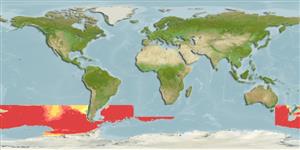>
Lophiiformes (Anglerfishes) >
Oneirodidae (Dreamers)
Etymology: Oneirodes: Greek, 'oneiros' = a dream or dreamlike or out of a dream (suggesting this fish is so strange and marvelous that can exist only in dreams) (Ref. 86949).
Environment: milieu / climate zone / depth range / distribution range
Ecología
marino batipelágico; rango de profundidad 700 - 2000 m (Ref. 86949), usually 800 - 1100 m (Ref. 86949). Deep-water; 36°S - 77°S
Southern Ocean: sub-Antarctic and Antarctic waters.
Tamaño / Peso / Age
Maturity: Lm ? range ? - ? cm
Max length : 15.0 cm SL (female)
Short description
Morfología | Morfometría
Radios blandos dorsales (total): 5-7; Radios blandos anales: 4. Characterized by having escal morphology: esca with a stout, internally pigmented appendage, usually bearing a compressed papilla and 2 tapering filaments on distal tip; several small tapering filaments along posterior margin of anterior escal appendage; papilla and filaments of anterior escal appendage unpigmented; rounded or truncated terminal escal papilla with a distal streak of pigment; unpigmented, unbranched tapering posterior escal appendage as long as or shorter than escal bulb; absence of lateral and anterolateral appendages; relatively short and broad subopercle, without indentation on posterodorsal margin; length of ventral fork of opercle 25.2-32.2% SL; ratio of lengths of the dorsal and ventral forks of opercle 0.52-0.59; absence of epibranchial teeth; presence of teeth on pharyngobranchial II; upper jaw teeth 20-37, lower jaw teeth 22-48; teeth on vomer 4-7; dorsal fin rays 5-7; anal fin rays 4; pectoral fin rays 17-19; head length 35.0-46.2% SL; head depth 36.3-48.8% SL; premaxilla length 25.0-35.0% SL; length of lower jaw 38.3-50.0% SL; length of illicium 19.1-28.3% SL (Ref. 86949).
Larvae are epipelagic, young and adults are mesopelagic or bathypelagic (Ref. 47377). Minimum depth from Ref. 58018.
Life cycle and mating behavior
Madurez | Reproducción | Puesta | Huevos | Fecundidad | Larva
Pietsch, T.W., 1990. Oneirodidae. p. 212-213. In O. Gon and P.C. Heemstra (eds.) Fishes of the Southern Ocean. J.L.B. Smith Institute of Ichthyology, Grahamstown, South Africa. (Ref. 5186)
IUCN Red List Status (Ref. 130435)
Threat to humans
Harmless
Human uses
Pesquerías: sin interés
Más información
Nombres comunesSinónimosMetabolismoDespredadoresEcotoxicologíaReproducciónMadurezPuestaAgregación para la puestaFecundidadHuevosEgg development
Age/SizeCrecimientoLength-weightLength-lengthLength-frequenciesMorfometríaMorfologíaLarvaDinámica larvariaReclutamientoAbundanciaBRUVS
ReferenciasAcuiculturaPerfil de acuiculturaRazasGenéticaElectrophoresesheritabilidadEnfermedadesProcesamientoNutrientsMass conversion
ColaboradoresImágenesStamps, Coins Misc.SonidosCiguateraVelocidadTipo de nataciónSuperficie branquialOtolitosCerebrosVisión
Herramientas
Special reports
Download XML
Fuentes de Internet
Estimates based on models
Preferred temperature (Ref.
123201): 0.2 - 1.9, mean 1.3 °C (based on 19 cells).
Phylogenetic diversity index (Ref.
82804): PD
50 = 0.5000 [Uniqueness, from 0.5 = low to 2.0 = high].
Bayesian length-weight: a=0.01995 (0.00906 - 0.04395), b=3.01 (2.83 - 3.19), in cm total length, based on all LWR estimates for this body shape (Ref.
93245).
Nivel trófico (Ref.
69278): 4.1 ±0.7 se; based on size and trophs of closest relatives
Resiliencia (Ref.
120179): Medio, población duplicada en un tiempo mínimo de 1.4-4.4 años (Preliminary K or Fecundity.).
Fishing Vulnerability (Ref.
59153): Low vulnerability (10 of 100).
